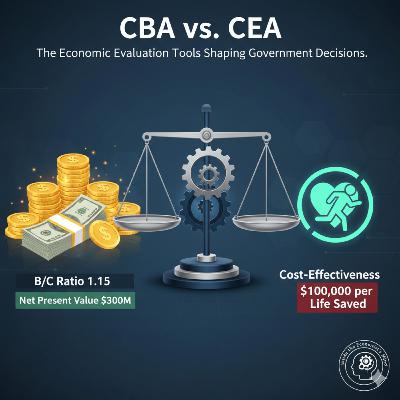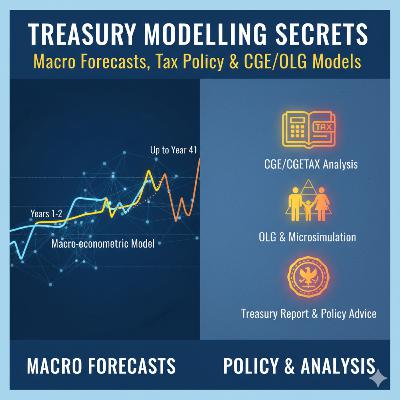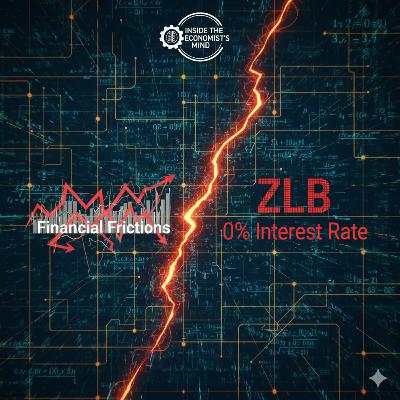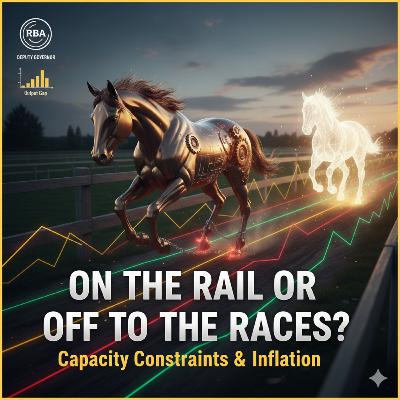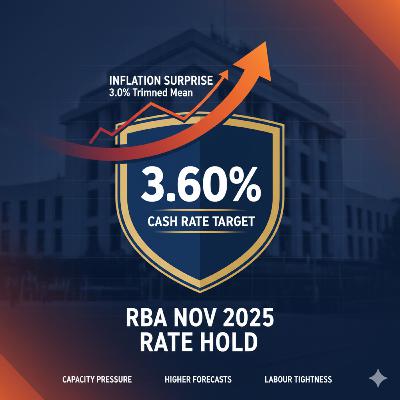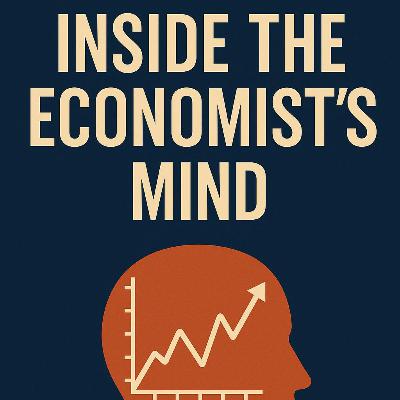Discover Inside the Economist’s Mind
Inside the Economist’s Mind

Inside the Economist’s Mind
Author: Economic Insight
Subscribed: 5Played: 28Subscribe
Share
© Economic Insight
Description
Inside the Economist’s Mind is a podcast that opens the door to how economists think, work, and solve real-world problems. Designed for economics students, early-career professionals, and curious minds, this show explores the logic behind big decisions—combining theory, data, and modelling with practical insights from the field.
61 Episodes
Reverse
Learn the different economic evaluation methods used to ensure efficient resource allocation. We explore when to use Cost-Benefit Analysis (CBA)—which converts all benefits into dollar values—and Cost-Effectiveness Analysis (CEA)—which calculates outcomes like ‘lives saved’ per dollar spent. Discover how these quantitative methods are applied ex ante to inform funding decisions and ex post to review program effectiveness. We also touch upon key considerations, including the complexity of assumptions and ethical issues like equity and discounting future generations.
Computable General Equilibrium (CGE) modelling is a central element of economic and policy debate in Australia, used for decisions ranging from tax reform to the approval of major projects. This report takes a deep dive into the surprising, little-known theoretical and design assumptions that fundamentally determine CGE model results and subsequent policy advice. Discover why CGE models often assume no money or interest rates, that inflation has no impact on the real economy, and that physical capital can be costlessly repurposed (meaning no stranded assets exist). Ultimately, the model results are 100 per cent determined by the subjective choices made by the modellers, often transforming these models into powerful tools of persuasion rather than objective analytical tools
Discover the complex economic models shaping fiscal advice at The Treasury. This review explores the critical recommendation to move away from the current 3-phase forecasting approach and embed a new, high-priority macro-econometric model for projections that must span greatly varying time horizons, from two up to 41 years. We analyze the crucial roadmap for the Revenue Group, focusing on upgrading its capability to use the detailed CGETAX model for analyzing tax policy impacts (covering up to twelve categories of tax). Learn why linking this CGE analysis with microsimulation models like CAPITA and PRISMOD.DIST is recommended for consistency in assessing both economic efficiency and household equity impacts. Finally, find out why Overlapping Generations (OLG) models are a medium priority for the Fiscal Group, as they are crucial tools for scenario analysis concerning intergenerational issues like retirement incomes and public debt policies.
Dynamic Stochastic General Equilibrium (DSGE) models are the leading, transparent tool for macroeconomic policy assessment. Discover why these models failed to predict the 2008 financial crisis, and how economists are now fundamentally improving them by incorporating crucial elements like financial frictions and addressing the Zero Lower Bound (ZLB). Learn how these complex, data-based models are used by institutions like the Federal Reserve to sharpen policymaker judgment worldwide
Delve into the Australian economic outlook with insights derived from the speech of Andrew Hauser, Deputy Governor of the Reserve Bank of Australia (RBA). This episode explores the "unusual challenge" facing monetary policy, noting that the GDP recovery began with the highest level of capacity utilisation in over 40 years. We analyze the RBA's decision to maintain a restrictive policy stance until confidence is achieved that underlying inflation will settle sustainably at the 2–3 per cent target range.Learn about the three potential tracks the economy could take, framed by the Melbourne Cup metaphor:1. Track A: Still ground to make up? (Policy easing may be necessary).2. Track B: Boxed in on the rail? (Little scope for further policy easing due to capacity constraints).3. Track C: Off to the races? (Escape through growing the economy’s supply capacity via productivity and investment).Understand why addressing weak growth in supply capacity and driving investment is crucial for Australia to avoid being "boxed in on the rail" and instead be "off to the races.
In this episode of Inside's Economist's Mind, we break down the Reserve Bank of Australia’s (RBA) decision in November 2025 to leave the cash rate target unchanged at 3.60 per cent.Drawing on the latest Statement on Monetary Policy, we analyze the surprising strength of the September quarter inflation data, which was "significantly stronger than expected". Year-ended trimmed mean inflation (a measure of underlying inflation) increased to 3.0 per cent, reflecting larger-than-expected price increases in several areas.The RBA now assesses there is slightly more capacity pressure in the Australian economy than previously thought. This persistence, coupled with the strong September outcome, has led to a revised outlook where underlying inflation is expected to remain above the 2–3 per cent target range until the second half of 2026. We examine the domestic drivers of this inflationary persistence, including higher prices for new dwellings and market services (like restaurant meals and takeaway food).Finally, we discuss the mixed signals in the labour market, where conditions have eased slightly (the unemployment rate increased to a quarterly average of 4.3% in September) but indicators like unit labour costs and high capacity utilisation still point to residual tightness.
In this episode of "Inside the economist's mind," we dissect the historic United States–Australia Critical Minerals Framework, a strategic partnership signed by Anthony Albanese and Donald Trump designed to challenge China’s near-complete hold, or "iron grip," over the essential materials required for global industries.The 8.5billiondealbetweenthealliesinvolvesacommitmentofatleast∗∗US1 billion from both the US and Australia** towards a pipeline of rare earth mineral projects. We explore how this agreement aims to secure mineral supplies for both countries' commercial, clean energy, and defense industries, particularly advanced military hardware.Key projects receiving capital injections include a proposed gallium plant in Western Australia (to be co-located at an Alcoa alumina refinery), and the Arafura Rare Earths project in the Northern Territory, which plans to produce oxides like neodymium and praseodymium, crucial for magnets used in wind turbines and ballistic missile guidance systems. Gallium is vital for modern military technologies, such as radar and missile guidance technology, and the US is currently wholly dependent on China for its import.However, the effort faces significant economic challenges. China has maintained its dominance through strategic tactics, including price manipulation of unprocessed rare earths to undercut rivals, and has recently expanded export controls on rare earths used by the US defense sector. While the framework includes measures to develop price floors to stabilize the market for new producers, economists note that the sector is so politicized that government money often acts as a necessary subsidy.We discuss the strategic shift required, noting that raw supply diversification is meaningless without establishing midstream refining and processing capacity outside of China. Furthermore, the deal is explicitly designed for delivery to American and Australian buyers, raising questions about how China, the world’s dominant buyer of high-grade magnet materials, will respond
This episode dives into the massive, yet highly controversial, Barossa offshore gas project, operated by Santos. Approved amidst an election campaign focused on gas exports, Barossa is one of the most polluting new gas projects under development in Australia.We explore the dual controversies surrounding the project:1. The Darwin Methane Leak Scandal: The Barossa project relies on extending the life of the existing Darwin Liquefied Natural Gas (DLNG) plant. Confidential documents reveal a "dirty secret": a design fault dating back to 2006 caused a major methane leak from the DLNG storage tank, a highly potent greenhouse gas up to 80 times more harmful than CO2. Estimates of the leak have varied, ranging up to the equivalent of millions of tonnes of CO2, or more than 8,000 new cars on the road every year it is in use. Critics call the handling of this leak a "national scandal" and a "cover-up" by Santos, ConocoPhillips, and regulators. Despite the opportunity to repair the faulty tank while it sits empty, Santos has chosen not to, deeming the decision a commercial one, and regulators have not forced a fix.2. The Export/Tax Paradox: Barossa highlights a core flaw in Australia's energy policy. The project is expected to deliver long-term cash flows and supports energy security in Asia. However, The Australia Institute notes that Barossa will pay no royalties on the gas it extracts, and like other gas exporters, none have ever paid the Petroleum Resource Rent Tax (PRRT). Excessive gas exports have been blamed for causing Australian domestic gas and electricity prices to triple, leading politicians to propose forcing exporters to divert uncontracted gas to Australian customers. Despite being the world’s second-largest LNG exporter, Australia is now preparing to import significantly more expensive LNG (Asian spot prices are far higher than domestic production costs) to cover pending supply shortfalls in the southern states.We detail how the BW Opal Floating Production, Storage, and Offloading (FPSO) vessel recently arrived and was successfully hooked up at the Barossa field, keeping the project on track for first gas in the third quarter of 2025, while examining the massive investment in local jobs, training, and the Barossa Aboriginal Future Fund (BAFF).This episode asks: Can Australia justify approving massive, high-polluting export projects that pay little tax, while consumers face tripled energy costs and regulators allegedly enable a methane cover-up?
Australia's green hydrogen transition faces severe setbacks due to high production costs, currently AUD 5−6 per kilogram, which developers cite as making the technology unviable. This cost hurdle, combined with the "chicken-and-egg problem" of uncertain market demand, has led to the cancellation of major projects, including the $12.5 billion CQ-H2 export venture. Further challenges include infrastructure bottlenecks, specialized transport complexity for liquid hydrogen, and unsustainable water resource demands required for large-scale production. Policy focus is now shifting to smaller, domestic industrial applications
Welcome to Inside the Economist's Mind. In this episode, we deep dive into the Resources and Energy Quarterly (REQ) September 2025 report. We analyze the dramatic shifts reshaping Australia's export landscape.The overall forecast projects that Australian resource and energy export earnings will decline by 5%, falling from $385 billion in 2024–25 to $369 billion in 2025–26. This overall decline masks a story of massive internal market volatility driven by macroeconomic uncertainty and accelerating global transitions.Key Takeaways from the September 2025 REQ:Gold Overtakes LNG: We dissect how record-high gold prices, which climbed above US$3,700 an ounce in mid-September, are expected to offset declines in energy exports. Gold is forecast to surpass liquefied natural gas (LNG) to become Australia's second highest value export in 2025–26.The LNG Collapse: LNG export earnings are forecast to fall sharply from $65 billion in 2024–25 to $54 billion in 2025–26 and further to $48 billion in 2026–27. This decline is primarily price-driven, reflecting a rapid fall in oil prices (which feed into LNG contracts) and rising global supply from the US and Qatar.Clean Energy Demand & Base Metals: Discover the increasing demand pressures on copper. The commodity's price is forecast to rise due to a strong, structural uplift in demand that is not being matched by rising supply. This demand is being driven by the expansion of clean energy technologies and the explosive requirement for electricity infrastructure to support new AI data centers.Critical Mineral Growth: We examine the market dynamics affecting critical minerals, including the global oversupply keeping nickel prices subdued. Conversely, Australian export earnings for manganese and rare earth elements are expected to drive growth in the "other critical minerals" category, lifting earnings to $5.0 billion by 2026–27.Join us as we explore the threats posed by softening world growth, rising trade barriers, and geopolitical tensions, and how these factors influence Australia's resource sector outlook.
Discover how Australian petrol pump prices are determined by key factors, including international product costs (like the Singapore MOPS95 benchmark), government taxes (excise and GST), and industry operating expenses. Learn about the impact of supply chain logistics, local market competition, and discounting cycles that influence prices across Australian cities and regions.• Australian petrol prices• how petrol prices determined Australia• petrol cost breakdown Australia• fuel prices Australia• petrol taxes Australia• excise tax petrol Australia• GST petrol Australia• Singapore MOPS95• petrol supply chain Australia• fuel market competition Australia• regional petrol prices Australia• petrol pricing benchmarks• fuel industry operating costs• Australian fuel imports
"The World Ahead" is an **annual predictive publication** from The Economist, released every November. It serves as a **forward-looking guide**, offering in-depth analysis, forecasts, and informed speculation across a wide spectrum of global affairs for the upcoming year. The Transformative Impact of Donald Trump's Return: A significant focus is placed on the ramifications of Mr. Trump's re-election, anticipating shifts in **U.S. immigration policy** towards mass deportations and stricter border controls. Globally, this is expected to lead to **renewed trade wars**, particularly with China, and a more transactional American foreign policy that could **strain traditional alliances**, raising questions about global security commitments. His administration is likely to push for a **winding down of the Ukraine conflict** and grant Israel greater autonomy in its regional engagements. The publication also notes the world's entry into a **"third nuclear age"** with more weapons and fewer arms control treaties, presenting new challenges for his presidency.Accelerating Technological Evolution and Its Constraints: The publication highlights a **"crunch time" for artificial intelligence (AI)**, with massive investments in data centers and advanced chips (like Nvidia's Blackwell), yet also acknowledges concerns about patchy adoption, uncertain real-world productivity boosts, and looming issues with data supply and regulation. On a more positive note, AI is expected to **accelerate drug development**, with AI-inspired medicines nearing regulatory approval, and will play a role in **cancer vaccine advancements**. The clean energy sector is poised for a **boom in grid-scale energy storage**, driven by renewable energy surges and demand from AI data centers, alongside progress in diverse storage technologies and even **fusion power** moving closer to commercial viability through private ventures.* **Evolving Global Geopolitics and Regional Dynamics**: Challenges and opportunities are foreseen across continents. **China's aging population** is driving the development of a "silver economy," while its entrepreneurs navigate domestic policy shifts and U.S. chip bans, pushing many Chinese firms to **expand globally** to circumvent tariffs. Conflicts in **Sudan**, the **Middle East**, and rising tensions in the **South China Sea** are identified as critical flashpoints. Europe is urged to bolster its **defence capabilities**, facing a potential decrease in U.S. security commitment. India's economy is projected to **overtake Japan's**, though without creating a comparable "China shock," and democratic stability in various Asian nations, like Indonesia and Thailand, faces challenges.* **Key Economic and Societal Trends**: The **American economy is anticipated to remain robust** despite potential risks from Trump's protectionist and anti-immigration policies. The **British economy** seeks sustained growth after years of sluggishness, with domestic political fragmentation anticipated within the new Labour government. There's an expected **backlash against "radical" diversity, equity, and inclusion (DEI) schemes**, leading to their "slimmed down" adoption, while genuine diversity efforts may continue. The **streaming "golden era" is expected to slow**, with rising prices and more advertisements, while **video game adaptations** are set to become a major force in film and television. Furthermore, the publication explores the potential for global **emissions to peak** and discusses the phenomenon of **"overtourism"** beginning to subside as travel patterns normalize.* **"Implausible-Sounding Scenarios"**: Reflecting the unpredictable nature of modern times, the publication also explores a range of unlikely but potentially high-impact events for 2025, including a **devastating solar storm**, the use of **4G cellular technology on the Moon**, the possibility of **another global pandemic**, or even the **discovery of lost ancient texts using AI.
Welcome to Inside’s Economists Mind—a podcast where economic thinking meets real-world impact.You’re listening to our Career Conversations series, where we explore the journeys, challenges, and strategies that shape the careers of economists in Australia.Today’s episode is all about mastering behavioral interviews at the ATO. If you’re preparing for an Economist or Research Analyst role in the public sector, this one’s for you.We’ll unpack the STAR method, walk through tailored examples, and show you how to align your experience with ATO values and expectations.
In this episode, we dive into NAB Economics' preview of Australia's Q1 2025 GDP, which forecasts a 0.5% quarter-on-quarter rise. The growth is expected to be led by private sector momentum, particularly through business and dwelling investment, even as consumer spending shows signs of cooling. We'll explore how this outlook aligns with the Reserve Bank of Australia's expectations and what it means for inflation, the labor market, and future economic policy. Plus, we discuss the challenges ahead in sustaining investment and reviving consumption to support long-term growth.
Key points:Population growth peaked just above 2.5%yr in Q3 2023 due to a surge following the reopening of international borders, driven by the return of students and arrival of approved permanent residents who were delayed by the pandemic.Similar patterns of population growth surges and corrections have been observed in other countries like Canada, New Zealand, the United Kingdom, and Germany.While previously expected to finish 2024 around a 2%yr pace, official data for Q3 2023 showed the annual growth rate had already declined to 1.8%. Both Westpac and the RBA are now operating under an assumption of 1.7%yr growth for calendar year 2024.The reason for the faster-than-expected slowdown is not entirely clear, but potential factors include an apparent slowdown in processing times for some visa classes and increased departures of long-term non-permanent residents.Working-age population growth initially outpaced total population growth, likely because the catch-up surge was skewed towards young adult students. This gap is closing as the overall population surge unwinds.Official Labour Force Survey (LFS) estimates of the working-age civilian population may be revised in the future when benchmarked against official population data. Focusing on ratio measures like the employment-to-population ratio, participation rate, and unemployment rate is suggested for better interpretation of near-term labour market developments, as these are more robust to changes in estimated population growth.Lower population growth implies less pressure on housing markets. The earlier surge in population growth contributed to the rise in rent inflation and a boost to housing prices despite high interest rates. As growth slows, rent inflation is expected to slow, and the impact of lower interest rates on established housing prices might be less than usual.State-level population growth varies considerably; for example, in the year to Q3 2023, Victoria (2.1%yr), Queensland (2.0%yr), and WA (2.5%yr) had growth rates above the national pace, while NSW lagged (1.4%), partly due to negative net interstate migration.Demographic variables, although often considered slow-moving, can change quickly, especially in the aftermath of events like the pandemic.The primary topics covered in the article include:Population growth (specifically in Australia and its recent downswing)The Labour market and implications for employment growthThe Housing market, including impacts on demand, rent inflation, and housing pricesAustralian economics in generalThe Reserve Bank of Australia (RBA) assumptions and forecasts related to population growthData from the Australian Bureau of Statistics (ABS), particularly regarding population and labour force estimatesState-level variations in population growth within AustraliaThe impact of post-pandemic recovery and border re-openingsComparisons with population trends in other peer economies (Canada, New Zealand, UK, Germany)Migration trends (students, permanent residents, interstate)
Australia's population growth surge following the reopening of international borders is now unwinding faster than previously indicated, reaching an annual rate of 1.8% in Q3 2024 and is now assumed to be 1.7% for calendar year 2024 by both Westpac and the RBA. This slowdown is expected to **reduce demand pressure on the housing market** and implies that **rent inflation should slow further**.* There is currently a **high degree of uncertainty** in the global economic outlook, particularly surrounding bilateral trade negotiations and tariffs, which is impacting central banks.* The US economy is seen as "solid" with "solid" labour market conditions, but inflation is "somewhat elevated" with "significant uncertainties" stemming from trade and migration policies. The **FOMC is in a 'wait and see' mode**.* In New Zealand, the **RBNZ cut its official cash rate (OCR) by 25bps to 3.25%**, a decision made by a 5-1 vote. They **downgraded their economic forecasts** for 2025 GDP growth to 1.8%yr (from 2.4%) due to the weaker global outlook from increased trade protectionism.* Despite the rate cut and downgraded forecasts, the RBNZ showed caution regarding the timing and extent of future cuts, noting "no bias" for the July meeting and that future decisions will be data-dependent. Westpac's New Zealand economists now expect the next RBNZ rate cut in August rather than July.* In Australia, the April Monthly CPI Indicator showed headline inflation at 2.4%yr, while the **monthly trimmed mean ticked up to 2.8%yr, posing some upside risk to Westpac's Q2 CPI forecast**.* Australia's **Q1 GDP growth is forecast to slow to 0.4%qtr (1.5%yr)**, partly impacted by natural disasters and a slight decline in private CAPEX, though external demand brought forward ahead of tariff increases may provide some offset. Net exports are expected to add 0.4ppt to Q1 GDP growth.* Household spending in Australia looks like another soft month in April due to holiday disruptions and weak vehicle sales.
In this episode, we unpack Westpac IQ’s latest report on Australia’s construction sector for Q1 2025. With overall activity holding steady and a 3.5% year-over-year growth, residential construction is leading the charge. We also explore the evolving landscape of engineering construction, where traditional infrastructure takes a backseat to a growing wave of renewable energy projects. Plus, hear insights on how easing inflation is impacting builders and developers across the country. Whether you're in real estate, energy, or policy, this episode brings you the key takeaways shaping Australia’s construction future.
In this episode, we dive into the rising tensions between the US and the European Union as former President Trump threatens a sweeping 50% tariff on EU goods. Drawing from ING Think’s latest economic analysis, we explore the EU’s counteroffers, the strategic sectors at stake, and what a full-blown transatlantic trade conflict could mean for global markets. Is this brinkmanship or the beginning of a larger economic standoff? Tune in to understand the implications, the risks, and why a drawn-out trade war may not be in anyone’s best interest.
This week on *Westpac’s Australia & New Zealand Weekly*, we unpack the Reserve Bank of Australia’s latest rate cut and what it signals about inflation and domestic demand. We also analyze New Zealand’s newly released Budget and the potential path ahead for the Reserve Bank of New Zealand. With global uncertainties looming, our economists dive into key international developments and preview critical upcoming data from China, Japan, Europe, and the U.S. Plus, updated forecasts on interest rates and exchange rates to help you stay ahead.
In this episode, we unpack Paul Krugman’s take on deindustrialization in America. Challenging the popular blame placed on globalization and trade deficits, Krugman argues that the decline in manufacturing is part of a broader economic evolution—not a crisis to be reversed. We explore his case for moving beyond nostalgic policies and focusing instead on real solutions to support today’s workers in a changing economy.


